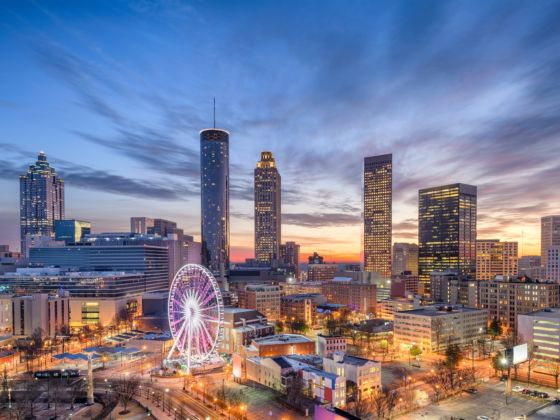

Atlanta was once the railroad hub of the Southeast and is now home to the world’s busiest airport. It has always been a go-getter town, but in the last decade, the business-forward metropolis has been cultivating its creative side, leading to inspired cuisine, splashy street art, a thriving music and film scene, and the revitalization of some of its most beautifully worn structures. Set in a hilly forest, Atlanta is host to an ever-expanding population of transplants from anywhere and everywhere who keep the capital of the South diverse and welcoming. Stroll its tree-lined neighborhoods, settle into a porch swing, or bike the Beltline. You’ll come for the Southern charm and stay for the food halls.
It’s best to visit Atlanta in the spring or fall when the temperatures are mild and the outdoors calls. Spring weather begins in mid-March and continues through May, with highs between 70 and 80 degrees Fahrenheit. During this time, this city is replete with blooming dogwoods, azaleas, and other flowering plants, and locals are out in full force to enjoy the scenery. Fall weather runs from mid-September through November, with highs descending by the month from the low 80s to the 60s. The city’s many trees brandish their fall foliage from mid-October through November. Many of Atlanta’s outdoor festivals take place during the spring and fall months, and the pleasant temperatures are perfect for enjoying lunch on a restaurant patio, a picnic at Piedmont Park, or a walk on the Atlanta Beltline. There’s no denying it: Atlanta summers are hot and sticky. From June through early September, temperatures average near 90 degrees with humidity approaching the same levels. August is the hottest of the hot months in Atlanta. The city’s winters run from December through March, with highs averaging in the 50s and lows in the 30s. It rarely snows in Atlanta, but rain and clouds are a common winter forecast.
Atlanta’s suburban sprawl has made for a car-dependent metro area, but thanks to rideshare services, MARTA transit, and other transportation options, these days it’s possible to navigate the city without renting a car. For example, for $2.50, a MARTA train can take you directly from the airport to downtown Atlanta, and from there to attractions in Midtown such as the High Museum of Art and Piedmont Park. Rideshare services Lyft and Uber are extremely popular in Atlanta because both make it easy to get from place to place without the headache of finding a parking spot. App-based rental electric scooters from Lime and Bird, electric bikes from Jump, and the city’s Relay Bike program bikes are scattered throughout the city sidewalks and along the Atlanta Beltline, offering yet another alternative for making one’s way short distances (though be advised that Atlanta’s bike lanes are a work in progress). And speaking of the Beltline, the new rails-to-trails greenway, which will eventually encircle the entire city, is an excellent way to navigate parts of the city on foot or two wheels. For day trips outside the city or into the Atlanta suburbs, it’s necessary to rent a car. Zipcar is available in Atlanta in addition to the other usual car rental companies, such as Hertz and Enterprise, which have pickup sites throughout the city and at the airport.
Generally speaking, Atlanta is a safe city. As with any large US metropolitan area, it’s best to avoid parks and green spaces after dark and exercise caution navigating unfamiliar areas on foot at night, especially if the area lacks pedestrian activity. Car break-ins are a common problem, so always lock doors and keep valuables out of sight within the vehicle. The city is extremely LGBTQ-friendly and welcoming to visitors from other countries.
Put down the macro lager.
The Eastside Trail is open and is an ATL must-see.
It’s called “The City Too Busy to Hate” for a reason.
Sips and bites with a view.